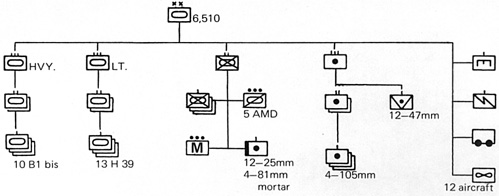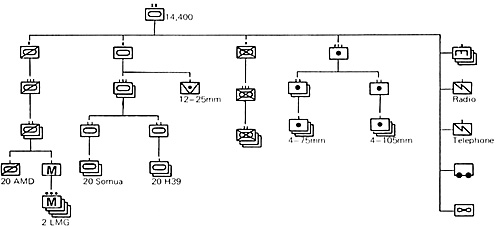Division Cuirassee (DCR)
AFV: 163
APC: 77
M/C: 400
Vehicles: 760
France's armoured division, the Division Cuirassee (DCR), was destined for a counter-attack role in the campaign in 1940. With half the number of armoured fighting vehicles (AFVs) of their German counterparts, and a token battalion of infantry, these divisions lacked firepower and depth. The only factor in their favor was the superior armour and guns on their heavy tanks, making them almost invulnerable to German anti-tank and tank guns.
The main tank component of the French Army at the beginning of the war, the 1st Groupment Cuirasee, was divided on 16 January 1940 to form the 1st and 2nd DCR. The 3rd DCR came into being on 20 March and the 4th DCR on 15 May.
The organizational outline of these divisions included two Demi-Brigades of two Bataillons de chars de combat (B.C.C.) each, separated into heavy (B1 bis) and light (H39) tanks. Each B.C.C. consisted of three companies, the B1 bis units of ten tanks each with a bttn HQ tank and three replacment tanks.
The H39 companies had thirteen tanks each, with an additional company HQ tank and three battalion replacement tanks. This gave a total of 34 heavy and 45 light tanks per battalion, or 158 for the division, of which 62 B1 bis and 84 H39 made up the actual fighting strength. De Gaulle's DCR 4 had one extra battalion per demi-brigade.
The small infantry component of chasseurs portis comprised three companies in armoured personnel carriers (APCs). An armoured car section of five AMDs, a section of motorcycles, and a company of 25mm guns and 81 mm mortars were also part of the battalion's integral make-up. Divisional artillery included a regiment of 105mm howitzers tractee tous terrains (tractor-drawn) with two groupes of three 4-gun batteries. A battery of twelve 47mm guns was the only anti-tank component of the division.
A company of sepeurs-mineurs (engineers), a signal company with telephone and radio equipment, and administrative, supply, and medical units completed the small structure of the division. An escadrille (squadron) of reconnaissance aircraft was also supposed to be provided for the DCR, but these aircraft rarely cooperated effectively in battlefield situations.
| Division Cuirassee (DCR) | ||||
|---|---|---|---|---|
| UNIT | DEMI-BRIGADE | B.C.C | EQUIPMENT | CONDITION ON 10 MAY, 1940 |
| DCR 1 | 1 | 8, 15 | B1 bis, H39 | Motorized artillery regiment had 3 groupes instead of 2; light deficit in personnel and H39 motorcycles. |
| 3 | 25,26 | |||
| DCR 2 | 2 | 8, 15 | B1 bis, H39 | Division had extra AT battery; most H39s had 37mm SA 18, not SA 38; no AMDs in the infantry battalion. |
| 4 | 14,27 | |||
| DCR 3 | 5 | 41,49 | B1 bis, H39 | 42 B.C.C. had only two companies; 50% deficit in infantry vehicles; shortage of artillery tractors and radios |
| 7 | 42,45 | |||
| DCR 4 | 6 | 46,47,19 | B1 bis, D2, H39, R35 | Division formed 15 May; 47 B.C.C. joined unit on 21 May; motorized art. regiment had 75mm guns, not 105mm; 6th Demi-Brigade had an extra company [345th] of D2 tanks. |
| 8 | 2, 24,44 | |||
| Other units attached to DCR 4:
3rd Cuirassiers. a cavalry regiment with one groupe of Somuas and one of H39s; 10th Cuirassiers reconnaissance (AMD) regiment, and one AMD escadron from 6th Cuirassiers: 7th Dragons Portes [infantry] regiment of two battalions; an extra groupe of artillery, one anti-aircraft battery, and up to 5 anti-tank batteries also served with the division. This gave De Gaulle's DCR 4 an AFV strength of 374, making it the strongest armoured division in the campaign. | ||||

Division Legere Mecanique (DLM)
AFV: 270-290
APC: 345
M/C: 1,500
Vehicles: 1,330
A conception of General Weygand, the Division Legere Mecanique (DLM), or Light Mechanized Division, was the best French armoured unit. On paper the equal of any German panzer division, only three DLMs were available for the campaign. The 1st and 2nd DLM were formed in late August, 1939; the 3rd DLM not until 1 February, 1940. On 10 May, every division was complete in personnel and equip meet, and had undergone extensive training. The DLMs functioned under the Cavalry Corps, the French Army's only completely mechanized corps.
The DLM followed a very similar pattern to the panzer division. Its reconnaissance element was made up of a regiment decouverte with two groupes, each consisting of one escadron of armoured cars, and one of motorcycles (four sections). The combat AFVs were under a Brigade of two cavalry regiments. Each regiment of tanks contained two groupes, one of two escadrons of Somua tanks, the other of H39 tanks. There were twenty AFVs per escadron, and including escadron, groupe, and regiment HQ tanks, the division had a total of 87 Somoa and 87 H39 tanks. The armoured car (AMD) escadrons totaled 40 - 50 vehicles. 1,500 motorcycles, 345 APCs, and 1,330 trucks, tractors, and other vehicles formed the division transport.
A regiment of tractor-drawn 75mm guns and 105mm howitzers were organized into groupes of three 4-gun batteries. Two groupes of the former and one of the latter were in each DLM. An anti tank escadron of twelve 25mm guns was usually assigned to one of the cavalry combat regiments. Other divisional troops included a tank repair escadron with the combat brigade, three engineer companies, signal units of one radio and one telephone company (even a carrier-pidgeon detachment), and medical and supply units. An aircraft reconnaissance squadron was attached.
The infantry regiment of dragons portes had three 930-man battalions. Each battalion deployed five escadrons: two infantry, one motorcycle, one heavy-gun, and one of AMR tanks. Battalion armament comprised 68 light and heavy machine guns (450 total for the division), three 60mm and four 81mm mortars, and four 25mm anti-tank guns.
145 motorcycles (solo and combination types) and 115 Laffly half-tracks.
The 3rd DLM had H39 tanks in place of AMRs.

Legere de Cavalerie (DLC)
Originally, the Division Legere de Cavalerie (DLC), or Light Cavalry Division, was merely a cavalry division with a token force of armoured cars attached to it. In 1940 the motorized elements were increased considerably. The Germans had discovered in the Polish campaign that their light divisions' mixture of cavalry and tanks did not cooperate efficiently on the battlefield. Consequently, they converted the light divisions to solely panzer formations. The French had to learn the hard way.
By 10 May there were five DLCs in France. DLCs 1 - 3 were formed in early March from the original cavalry divisions, and DLCs 4 and 5 were newly-formed in February. All divisions were well-trained in maneuvres and equipment (which was often excellent!. DLC 5, for example, had new American six-wheeled trucks to transport its motorized infantry. Only DLC 1 was short in personnel (by 20%} and had some second-hand vehicles. DLC 5 had a deficit of 200 horses.
The division's cavalry element was made up of a brigade with two regiments, called hussars, chasseurs, dragoons, or cuirassiers. Although the names were different, the weapons, number of men, and organization were not. The light motorized brigade contained an armoured car regiment [automitraillouses] and a regiment of motorized infantry [dragons portes].
The armoured car regiment had six escadrons (squadrons) made up of one reconnaissance and one combat groupe. Each groupe had one motorcycle borne infantry escadron. Eleven solo- and combination-type motorcycles, 36 LMG and 2 - 60mm mortars were in each motorcycle unit. The reconnaissance groupe had an escadron of Panhard 1935 AMDs with 17 solo and 3 combination motorcycles. The combat groupe contained an escadron of two sections of H39 tanks (DLC 5 had H35s) with 16 solo and 7 combination motorcycles.
Total armament of the armoured car regiment was 590 rifles (7.5mm model 36), 192 machine pistols, 4 MG and 72 LMG, and four 60mm mortars. 90 solo and 131 combination motorcycles, along with 100 trucks and lorries, and 4 tractors (Laffly and Somua) made up the regiment's transport. Including section, escadron, groupe, and regiment HQ AFVs, there were 17 AMDs and 2Z H39 tanks for a grand total of 364 vehicles in the regiment.
The dragons portes were armed the same as in the other cavalry division, the DLM. The two battalions of motorized infantry included an escadron with 22 AMRs in the regiment, as well as one of the motorcyclists. This gave the DLC an AFV total of 61.
The artillery was originally horse-drawn, but became Laffly tractor drawn when the DLC came into being. An escadron of twelve 25mm AT guns was in the light motorized brigade, and included 6 LMG, 47 vehicles, and 172 men as well. 3 platoons, each of 2 two-gun groupes, provided AT protection within the brigade.

To these 51 battalions and 9 autonomous companies should be added the 14 groupes of H39 and Somua tanks of the DLMs. This gives a total tank strength of 68 1/2 battalions.
Another 18 battalions of tanks and armoured cars in DLMs and DLCs make a grand total of 96% AFV battalions. Battalion strengths varied tremendously in the
French Army. R35, H35/39, and FCM combined 45 tanks per battalion, 15 in an autonomous company. A B.C.C. of D2 had 40, the companies 20 vehicles. The obsolete FTs were formed into battalions of 63 tanks, autonomous companies of 15. The battalion of giant 2c tanks was made up of only six tanks. These slightly mobile pillboxes were being moved by railway to the north in June when the Luftwaffe caught them on their flatcars. The battalion never got into combat. A cavalry groupe of H39 and Somua tanks had 43 vehicles.
The 3 British Royal Tank Regiments had 62 tanks apiece, the 3 cavalry regiments each had 58 light tanks. The Army Brigade's 2 battalions each had 57 tanks. Seven divisional cavalry regiments were made up of 28 light tanks each. A German battalion comprised 55 - 75 tanks. There were 35 of these plus 10 armoured car battalions in the Panzer Divisions.
| TANK | BATAILLONS DE CHARS DE COMBAT (BCC) | TOTAL |
|---|---|---|
| R35 | 1, 2, 3, 5, 6, 9, 10, 12, 16, 17, 20, 21, 22, 23, Z4, 32, 34, 38, 39, 40, 43, 44, 48 | 23 |
| H36 | 13, 35 | 2 |
| H39 | 14, 25, 26, 27, 42, 4Ei + autonomous companios 342, 351 | 6+ |
| FCM | 4, 7 | 2 |
| D2 | 19 + companies 345, 346 | 1+ |
| B1 bis | 8, 15, 28, 37, 41, 46, 47, 49,+ companies 347, 348, 349 | 8+ |
| [FT] | 11, 18, 29, 30, 31, 33, 36, Colonial + companies 343, 344 | 8+ |
| [2c] | 51 | 1 |
More 1940
-
1940: Campaign in France
1940: Campaign in France: Military Dictionary
1940: Campaign in France: TO&E: French
1940: Campaign in France: TO&E: British
1940: Campaign in France: TO&E: German
1940: Campaign in France: Tank Illustrations and Specs
1940: Campaign in France: Anti-Tank Gun Comparison
1940: Campaign in France: Order of Battle Numerical Charts
Back to Conflict Number 1 Table of Contents
Back to Conflict List of Issues
Back to MagWeb Master Magazine List
© Copyright 1998 by Dana Lombardy
This article appears in MagWeb (Magazine Web) on the Internet World Wide Web.
Other military history articles and gaming articles are available at http://www.magweb.com